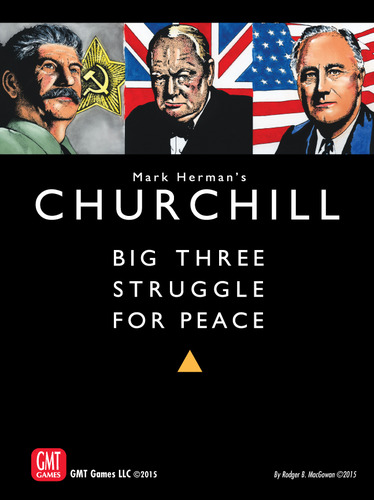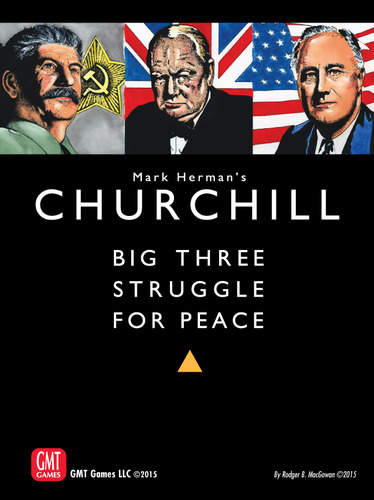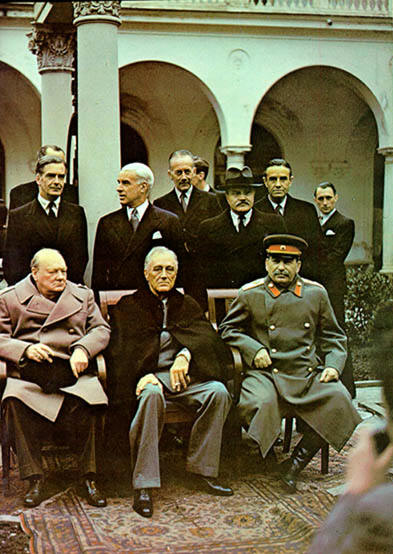
Finest Hour 170
Books, Arts & Curiosities – Strategic Thinking

December 3, 2015
Finest Hour 170, Fall 2015
Page 47
Review by J. Peter Rich and Steve Carey
Mark Herman, Churchill: Big Three Struggle for Peace, GMT Games, 2015, $70. ASIN: B013SCRACW
 Three personalities dominated the allied conferences of the Second World War, whether or not they were all present in person: British Prime Minister Winston Churchill, US President Franklin Roosevelt, and Soviet Premier Joseph Stalin. Now the ten major conferences are the subject of a new board game, appropriately named Churchill: Big Three Struggle for Peace, a 2015 release from GMT Games, one of the leading producers in the genre of table-top, conflict simulations.
Three personalities dominated the allied conferences of the Second World War, whether or not they were all present in person: British Prime Minister Winston Churchill, US President Franklin Roosevelt, and Soviet Premier Joseph Stalin. Now the ten major conferences are the subject of a new board game, appropriately named Churchill: Big Three Struggle for Peace, a 2015 release from GMT Games, one of the leading producers in the genre of table-top, conflict simulations.
Though technically classified as a “war game,” Churchill is more of a political design of simultaneous cooperation and competition where each of the three sides (the US, the UK, and the USSR) strives to advance its own national agenda. Long-time conflict simulation designer Mark Herman has injected a series of innovative concepts into the game that compel players to think and act in a manner similar to their historical counterparts.
This is not a family board game along the lines of Monopoly or Risk, nor is it nearly as easy to learn and as quick to play as chess. A session requires a minimum commitment of three hours for the tournament game (the last five conferences) and may take the majority of a day for all ten conferences. But the game is never boring because, unlike other multiplayer games, players are constantly involved, with almost no “down time.”
By design, Churchill is a game which, in order for a player to prevail, requires constant situational assessment and reassessment, careful strategy based on swift analysis of the everchanging situation, bluffing, and creativity. Unlike other games, the side that scores the most points does not necessarily win. The game tries to mimic the central goal of the conference participants to  cooperate with allies. Thus a player that leads with too many points over the last-place opponent may lose to the second-place player. Preserving the alliance is key, with players attempting to leverage their allied partners while still maintaining a fragile bond as the war draws to an end.
cooperate with allies. Thus a player that leads with too many points over the last-place opponent may lose to the second-place player. Preserving the alliance is key, with players attempting to leverage their allied partners while still maintaining a fragile bond as the war draws to an end.

2024 International Churchill Conference
All of this is simulated on an abstract playing board, which represents multiple military fronts and also a conference table where specific issues (e.g., the atom bomb; US and UK production; US, UK, and Soviet-directed military offensives) are presented, debated, and won via the careful play of strategic staff member cards. The cards represent the important individual staff members of each of the three powers (Brooke, Attlee, Eden, and Beaverbrook for Churchill; Hopkins, Marshall, Stimson, and King for FDR; and Molotov, Beria, Zhukov, and Zhdanov for Stalin), all of whom have their own special attributes and numerical values based on their historical strengths and weaknesses. How these staff cards are utilized is one of the key foundations of the game.
Stalin, Roosevelt, and Churchill each has his own personalized, and very powerful, leader card. When utilized, there are both positive and potentially negative game effects. For example, whenever Churchill’s card is used, he is not only deactivated for the rest of that conference but may miss the next conference (based on a die roll) due to a heart attack or other health problems. Stalin faces the risk of paranoia, and his staff members may be liquidated by the dreaded Beria. Similarly, FDR has a risk of dying whenever his card is implemented.
When not present at a conference, a leader may not engage in advancing an issue but may still debate out-of-turn. When inactive due to prior debate or illness, the leader’s card may not be used at all, and the staff members will have to shoulder the burdens alone.
After a conference, the issues “captured” by each player are implemented on multiple battlefronts, from Europe to the Pacific. Points will eventually be scored based on which of the Allies advances the farthest and fastest against the Axis power that faces them. To simulate Churchill’s concern that D-Day might fail and his preference for the Italian campaign, the UK player will receive bonus points if Allied troops advance further into Italy before D-Day. However, if D-Day occurs too late and the Western Allies do not enter and defeat Germany, Churchill and FDR may lose points to a greedy Stalin.
If this all seems too complex, it is really much less so than it appears. Initially the game may be a bit daunting for new players, but after playing your first game things will proceed very smoothly. A short training scenario is provided with that in mind.
Churchill is a remarkable effort that not only conveys a strong sense of history but is also a lot of fun. The game is even playable as solitaire, since easy-to-use charts are included which govern the behavior of all three participants. Whether you choose the role of Churchill, Roosevelt, or Stalin, Churchill presents a rich and deeply satisfying board game experience.
J. Peter Rich practices law in Los Angeles and is a rules editor of historical strategy board games.
Steve Carey is a contributing editor for C3i magazine. He has published three historical board conflict simulations, including a solitaire game on the Pacific War.
Subscribe
WANT MORE?
Get the Churchill Bulletin delivered to your inbox once a month.


